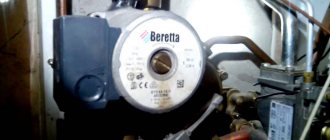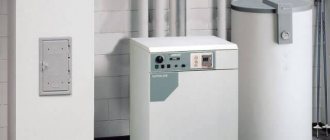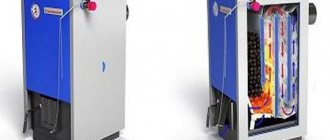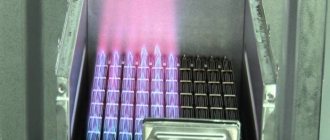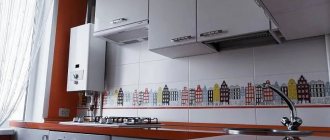Home / Gas boilers
Back
Published: 04/22/2020
Reading time: 4 min
0
992
Double-circuit gas boilers for heating and hot water are heat supply sources that are installed in individual housing stock: cottages or private houses.
As a rule, such units are capable of operating on two types of fuel: main gas and liquefied gas and can be either wall-mounted or floor-mounted. Among heating sources, such designs are the most popular.
This is explained by the fact that gas in Russia still remains the cheapest energy carrier in domestic heating supply schemes, and the design of such boilers can provide 100% automatic mode.
- 1 Types and features of dual-circuit gas units
- 2 Design of a double-circuit gas boiler
- 3 Operating principle
- 4 Advantages and disadvantages of dual-circuit devices
- 5 Characteristics of heat exchangers 5.1 Models with bithermic heat exchanger
- 5.2 Models with flow-through heater
Types and features of dual-circuit gas units
Double-circuit floor-standing gas boilers are available with a mini-boiler room kit. The user who purchased such a unit will not need to additionally purchase: a pump, a fan, an expansion tank, an air vent, as well as primary sensors of the automation system.
All this is supplied complete by the manufacturer and is effectively configured for the operation of the boiler. In some cases, even a coaxial chimney is supplied with the unit.
The Russian boiler equipment market is oversaturated with various modifications of units; to navigate them, they are grouped according to the following parameters:
- Design type: convection and condensation, the latter method is characterized by the highest efficiency, but the device is much more expensive and has a more complex maintenance process.
- Output thermal power (kW) is indicated separately for the loads for DHW and heating.
- Installation option: floor or wall.
- Firebox type: open with natural smoke exhaust and closed, with forced movement of the gas mixture in the combustion chamber, provided by a fan and a coaxial chimney.
- Burner ignition type: piezo ignition or electric ignition.
In contrast to single-circuit heating units, double-circuit heating units differ in the principle of distribution of hot water from a gas boiler.
It is necessary to select this equipment taking into account the characteristics of a heat exchanger capable of providing the DHW load and guaranteeing several “winter-summer” operating modes of the boiler.
Types and differences of gas boilers
Gas equipment may differ in both functionality and design, installation method, and automation equipment. These differences require more detailed description.
Single-circuit or double-circuit
If you want to save space, or simply not clutter your house with unnecessary equipment, the ideal solution would be double-circuit gas boilers for hot water supply to a private house or apartment.
They are called that because they are equipped with two heating circuits, one of which is closed (heating), the second is flowing (hot water supply). Depending on the installation location, they can be either wall or floor mounted.
For reference. Wall-mounted boilers are more compact, but their maximum power is limited. They are suitable only for heating standard apartments or relatively small country houses.
Diagram of a heating and hot water system from a double-circuit boiler
Connecting pipelines
Device diagram
The boiler can operate in one mode or two simultaneously
Wall and floor options
Double-circuit boiler with built-in boiler
The last picture shows a boiler not with a flow-through water heating circuit, but with a built-in boiler. Each of these schemes has its own pros and cons that need to be weighed before purchasing a unit.
The flow circuit provides water heating in a bithermic heat exchanger and has the following advantages:
- Fast heating;
- Constant availability of hot water;
- The gas boiler has compact dimensions.
Disadvantages include the formation of scale on the inner walls of the heat exchanger with hard water. This complicates the repair and maintenance of the unit and requires the installation of filters for water softening.
Unlike an instantaneous water heater, a boiler with a built-in boiler has two heat exchangers built into it. One heats the coolant from the burner flame, and in the second, the water is heated from the heating coolant and stored in a storage tank.
Photo of a floor-standing gas boiler with a built-in boiler
Advantages of this scheme:
- No scale in the heat exchanger;
- Ease of maintenance - the boiler can be cleaned and repaired without turning off the heating;
- There is always a supply of hot water.
The disadvantages are also obvious. These are the large size of the unit and a decrease in the rate of heating of water during its active consumption.
A single-circuit gas boiler is intended only for heating, therefore it is simpler and costs less. However, it can also be used to prepare hot water if, instead of one of the heating branches, an indirect heating boiler is connected to it.
Single-circuit gas boiler for hot water supply with a connected boiler
This design takes up much more space with the same efficiency as one double-circuit boiler. But its clear advantage is the stable temperature of hot water, which can be adjusted. In the case of instantaneous water heating, this is almost impossible.
With natural or forced draft
According to the type of draft, boilers come with an open and closed combustion chamber.
Difference between the two types of equipment
Units with an open chamber and natural draft, air for gas combustion is obtained directly from the room in which they are installed - and combustion products are discharged through a vertical chimney, exhausted through all ceilings and roofing. Only he can create a draft sufficient for smoke removal.
A vertical chimney is one of the disadvantages of natural draft boilers
To install such equipment, the following requirements must be met:
- Availability of a separate room. If there is no such room, then the room in which it stands must be non-residential. Most often this is the kitchen;
- The ceiling height must be at least 2.5 meters;
- The volume of the room should not be less than 15 cubic meters, plus 0.2 cubic meters for each kilowatt of heating device power;
- A high-quality ventilation system is required , capable of completely renewing the air in the room with the boiler three times an hour. It must be equipped with a door with a ventilation grille or a gap above the floor and a window with a window.
Boiler with an open burner in the basement of a house
In an apartment in a multi-storey building, installation of such equipment is not allowed. But in a private building, if there is a basement or a separate boiler room, it is preferable for two reasons:
- It costs significantly less than analogues with forced draft;
- Easier to maintain and repair.
This does not mean that you can install and repair such a boiler yourself. This is exclusively the prerogative of specialists from gas services.
In units with a closed combustion chamber, draft is created by a special built-in fan. They are equipped with a coaxial chimney “pipe in pipe”. On the inside, exhaust gases are discharged outside, and through the space between the pipes, fresh combustion air enters the boiler, sucked in by a fan.
The chimney is led out into the street through the wall and is located horizontally. This prevents debris and precipitation from getting into it.
Wall-mounted boiler with coaxial chimney
Fan
Outdoor chimney section
Scheme for the removal of combustion products through a traditional and coaxial chimney
Boiler with a closed chamber in a utility room
Installation in a closed cabinet is allowed
Since such boilers do not need air flow from the room, there are much fewer requirements for their installation. This can be any non-residential space in the house, and even a cabinet in the kitchen.
On a note. Please note that the fan operation creates a constant noise, which can be annoying if the unit is located in a frequently used area.
Availability of automation
The level of automation of their operation and control may differ for different units:
- The simplest device found even on the cheapest boilers is piezo ignition. The boiler is turned on only manually, by igniting the pilot burner, which then ignites the main burner. The downside is that the pilot light continues to burn during the entire operating time of the equipment, taking up to 20% of the gas. A simple device, a thermocouple, is responsible for shutting off the gas supply in the absence of a flame. The advantage of this scheme is the energy independence of the boiler.
Boiler with piezo ignition and thermocouple
- Volatile boilers with built-in automation are more economical to operate, but are more expensive. The pilot light in them does not burn constantly, and control of the functionality is much more convenient. You can turn the equipment on and off, adjust its power using a remote thermostat, and even remotely via SMS. You can program the temperature using a timer. But if there is a power outage, all these schemes will not work.
Control panel of a modern gas boiler
Design of a double-circuit gas boiler
A double-circuit gas boiler for heating has a special design of the combustion chamber, in which two heating circuits are located - heating and hot water.
In order to ensure their operation, the unit is made of the following elements:
- The burner device is the main element of the boiler, which ensures the creation of a gas-air mixture in ratios that ensure complete combustion of the fuel.
- The firebox or combustion chamber serves to transfer the released thermal energy from gas combustion to the coolant in heating and hot water circuits.
- An electric pump circulates water through the heating circuit.
- A blower fan for closed-type furnaces supplies air to the mouth of the torch for complete combustion of fuel. In addition, it creates the necessary pressure of flue gases for its release through the coaxial chimney system into the surrounding space.
- The safety group is equipped with a safety valve, air vent and primary sensors of the automatic control and safety system.
- A three-way valve switches the movement of coolant through the heating and hot water circuits.
- Basic heating heat exchanger.
- DHW heat exchanger for heating cold water.
- Connections for supplying and discharging coolant to the heating circuit.
- Mud trap and water purification filter.
- Expansion tank, storage tank.
In certain modifications of double-circuit gas boilers, twin heat exchangers are installed, in which the coolant is switched between heating circuits inside the housing. However, the operating principle of such a unit does not change.
Principle of operation
The thermal regime for a gas boiler is set using modern weather-dependent automation, which is adjusted according to the outside air temperature, and therefore the principle of its operation is simplified as much as possible. The process of starting and operating the unit is controlled by a microprocessor.
At this time, when the water in the heating circuit reaches the set temperature, the burner switches to modulation mode or, in other words, standby mode. The thermal cycle resumes when the water temperature in the circuit drops below the user-set conditions.
A fan built into the design in closed models supplies primary air to the furnace to ensure complete combustion of gas and creates an aerodynamic regime of flue gas movement sufficient to completely remove waste flue gases into the atmosphere.
When there is weak hot water pressure in the heating circuit, a centrifugal pump is installed, which directs the coolant to the final heating point in the house and returns it back to the boiler.
An electromechanical three-way valve switches the coolant between the DHW and heating circuits. When the user turns on the hot water tap on the mixer, the three-way tap directs the coolant through a small circuit, as a result the hot water is heated in high-speed heating mode.
The heating system does not work during this period. After turning off the tap on the mixer, the three-way valve switches the coolant to heating.
How does a single-circuit wall-mounted boiler work?
A gas single-circuit boiler consists of a gas burner device, a heat exchanger, a circulation pump and an expansion tank. In the lower part, the heating system pipes, water supply and gas pipe are connected to the boiler.
The operating principle is determined by the presence of an external water heater. If it is not there, the boiler only works to heat the coolant. As soon as the set temperature is reached, the GGU turns off and the boiler goes into standby mode. If an external water heater is connected, the GGU turns off at the moment when the water in the boiler heats up to the desired temperature. To minimize losses, it is recommended to install the boiler as close to the boiler as possible.
Prices for wall-mounted modifications reach up to 40 thousand rubles, depending on power, efficiency, trademark and other factors.
The advantages of boilers without hot water include low price, compact size, easy repair and maintenance. There are also disadvantages. These include a power limitation of no more than 35 kW. This is enough to heat a room up to 350 square meters. meters.
Advantages and disadvantages of dual-circuit devices
Today, double-circuit gas boilers are among the most energy-efficient heating equipment. However, they have both their advantages and disadvantages.
Advantages of a double-circuit boiler:
- Low specific gas consumption for generating a unit of thermal energy; modern units have an efficiency of 90-92%.
- Compactness and light weight, which is why most double-circuit units are available in wall-mounted versions, which allows them to be placed even in small-sized kitchens.
- Universal heat supply system. There is no need to purchase additional auxiliary equipment and adjust it to the boiler parameters.
- In the warm season, such a device works great for heating hot water, which allows you to rationally use the heat source throughout the year.
Disadvantages of a double-circuit boiler:
- With large water consumption, it is impossible to ensure high-quality simultaneous operation of two circuits on a gas boiler: heating and hot water.
- Limited models in terms of thermal power.
- The compactness of the combustion chamber is not always able to ensure the required operating mode of the boiler for hot water supply, especially when water points are located remotely.
- Sensitivity to the quality of the source water, which causes premature failure. The DHW plate heat exchanger works very poorly on hard water.
- Many users attribute its increased cost to the disadvantages of a double-circuit boiler. But experts say the opposite, compared to the options when it is necessary to additionally purchase an indirect heating boiler or install a gas water heater.
Single-circuit boiler + gas water heater
In the second part of our article, we looked at the heating + DHW scheme based on double-circuit floor-standing boilers (AKGV). Now let's look at a scheme that is also very popular, when the coolant in the heating system is heated by a single-circuit gas heating boiler (gas-water heating device AOGV), and water for household needs is heated by a separate device - a flow-through gas water heater (also called a gas water heater).
The main difference between these schemes is that these two devices operate independently of each other, thanks to which we get the main advantage: the boiler may not work in the summer.
What does this give us?
- A gas boiler of the AOGV type can be installed in the kitchen or in any other permitted room, because in the summer it will not “fry”.
- The reliability of the system increases. Failure of even a boiler or a dispenser will not lead to a complete collapse of engineering systems.
- A single-circuit boiler can be of any power, at least 100, at least more kilowatts in heat
The remaining pros and cons are similar to the scheme described in part 2 of the article:
- both the AOGV single-circuit boiler and the column are also simple and reliable (most of the columns also do not require connection to the electrical network);
- all spare parts are also inexpensive and common, everything is cheap, cheerful and repairable
- geysers can be much more productive with hot water, but still will not handle a large number of water points
The moral of this story: a heating and hot water scheme based on a floor-mounted single-circuit gas boiler and a gas water heater is more universal than based on a double-circuit AKGV boiler and is applicable for houses with permanent residence, of any size, but with a small number of water points (up to 5) and, accordingly , with low water consumption.
Heat exchanger characteristics
In modern double-circuit boilers, two types of boilers are mainly used - bithermic and flow-through. The first one is more used when domestic hot water consumption is low. Flow-through heaters have a developed heating surface, which ensures high water heating speed and large volumes.
Models with bithermic heat exchanger
Heating of the coolant in a gas boiler equipped with a bithermic heat exchanger occurs due to the circulation of the coolant through copper channels, the sections of which are made with a complex configuration inside the housing.
The heating coolant circulates through the external channels, and heated water for hot water is inside the tubes. The heat exchanger receives heat from the operating gas burner device.
Operating principle of a bithermic heat exchanger:
- In heating mode, at a low coolant temperature in the circuit, an electromechanical gas flow valve supplies gas to the nozzle, which is ignited by a piezo igniter.
- The fuel burns, and the released heat is transferred through the walls of the heat exchanger to the coolant.
- When the set water temperature is reached, the gas supply to the double-circuit gas boiler stops and turns on automatically when it decreases.
- When the user opens the hot water tap on the mixer, tap water will begin to flow into the DHW heating circuit of the bithermal heater. The coolant enters the small hot water circulation circuit and quickly heats the cold water.
- After the DHW tap is closed, the valve redirects the coolant to the heating circuit.
Models with flow-through heater
The principle of operation of boilers operating on gas fuel, in the design of which a separate flow-through heat exchanger for domestic hot water is installed, is that the coolant for heating and hot water is heated in separate housings.
In a flow-through DHW heat exchanger, tap water is heated by a heating fluid, which is switched by a three-way valve.
At this moment, the water in the heating circuit of the in-house heating system continues to circulate through a separate heat exchanger, naturally, without receiving heat. In order for the system to operate reliably, an electric circulation pump and two separate expansion tanks for each circuit are integrated into it.
This scheme is more efficient in terms of specific fuel indicators, can provide a larger load for domestic hot water, and is not so sensitive to the quality of the source water. In addition, the heating surfaces of the heat exchangers are designed in such a way as to ensure maximum heat removal from the combustion chamber.
For example, in a hot water supply circuit, the flows of coolant and cold water are directed according to the countercurrent principle, which allows for maximum temperature reduction in the heating circuit and reduces the processes of scale formation on the internal heating surfaces of the heat exchanger.
